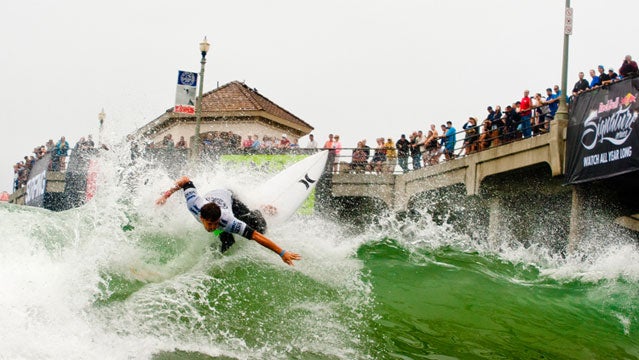It was an odd finish to an event that is as famous in the surfing world for non-stop action as it is for its music festival-like atmosphere. At about 12:30 on Sunday afternoon, the final day of the eight-day , Kolohe Andino and Alejo Muniz floated next to each other in the ocean on the Southside of the Huntington Beach pier. There were thirteen minutes left in their 35-minute finals’ heat, and $100,000 on the line. They each surfed seven heats to get there, knocking out one hundred twenty-two other surfers from around the world. In the twenty-two minutes that had already elapsed, the 23-year-old Muniz of Santa Catarina, Brazil, had carved his way to a solid lead, and Andino, a 19-year-old from San Clemente, needed an 8.46 out of a possible 10 points, no small task in the three-foot waves on offer. And then something strange happened: nothing. The ocean went flat for the final thirteen minutes of the contest and Muniz was crowned the 2013 U.S. Open champion.
 The 2013 U.S. Open champs.
The 2013 U.S. Open champs.It was strange for the simple fact that “nothing” never seems to happen at the U.S. Open. Besides Men’s, Women’s and Junior’s competitions, the event features skateboarding, BMX and multiple concerts (this year, Modest Mouse headlined). So perhaps it wasn’t surprising that, a few hours after the final, something did happen. A large fight broke out on Main Street that quickly spread through the still-swollen downtown crowd. Rioters flipped a row of portable toilets and used street signs as battering rams to shatter storefront windows. It took eight arrests and a number of hours before police in riot gear were able to use tear gas and non-lethal bullets to restore order.
Huntington Beach is no stranger to chaos at surf competitions. In 1986, during the final heat of the OP Pro, a riot erupted behind the bleachers that ended with flipped police cars on fire and a destroyed lifeguard headquarters. The event allegedly began when a woman flashed her breasts at a group of drunk men who then tried to grab her.
In the aftermath, the sale of alcohol at the event was banned and the date was changed from Labor Day weekend.
It’s hard to say why this year’s much smaller-scale rioting happened. But the sheer size of the crowds can’t have helped.
Nowhere are professional surfers closer to rock stars than each July when the U.S. Open steamrolls through town. After all, major surf events are usually held on far-flung islands like Hawaii, Tahiti, and Fiji, forcing fans to watch the online webcast or pony up a few grand in travel and expenses. But each day of the US Open, up to 150,000 sun-baked, bikinied, Red-Bull-fueled surf fans parade along the beach, snag free shwag and watch the best surfers in the world go at it in the peaky beach break waves. “This is the biggest win of my career,” said Muniz “and it’s the biggest crowd I’ve ever surfed in front of.”
It was a shame that the rioters detracted from what was otherwise a well-contested and thrilling event. On the women’s side, Hawaiian Carissa Moore, 20, beat Courtney Conlogue, 20, despite a last-minute attempt at heroics by the hometown favorite. At the buzzer, Conlogue caught a long wave that allowed her to get in a crisp series of back-hand turns. But the score wasn’t enough. “I thought Courtney won when the crowd erupted on that last wave,” said Moore. “But I’m stoked it worked out in my favor.” The win moved Moore up into the number one spot in the women’s World Title race, a trophy she last won in 2010. Hopefully in the future it will be the theatrics in the water that continue to make headlines, and not the hooligans on the streets.


